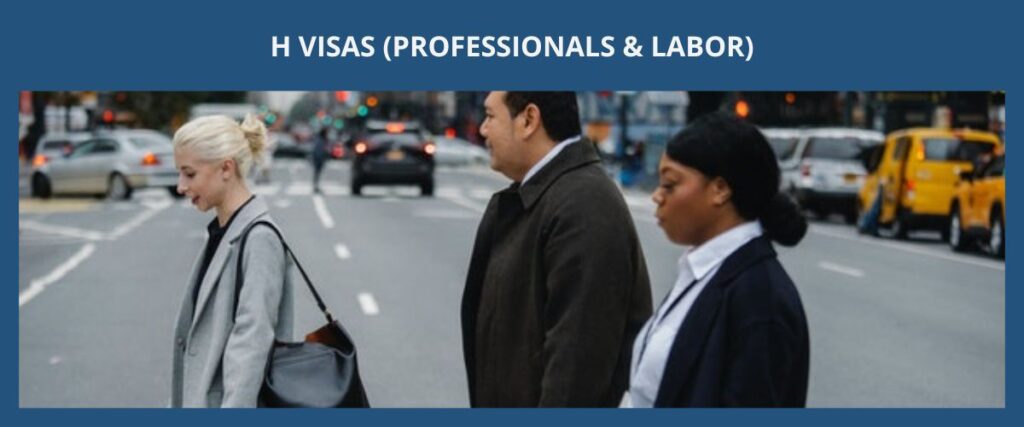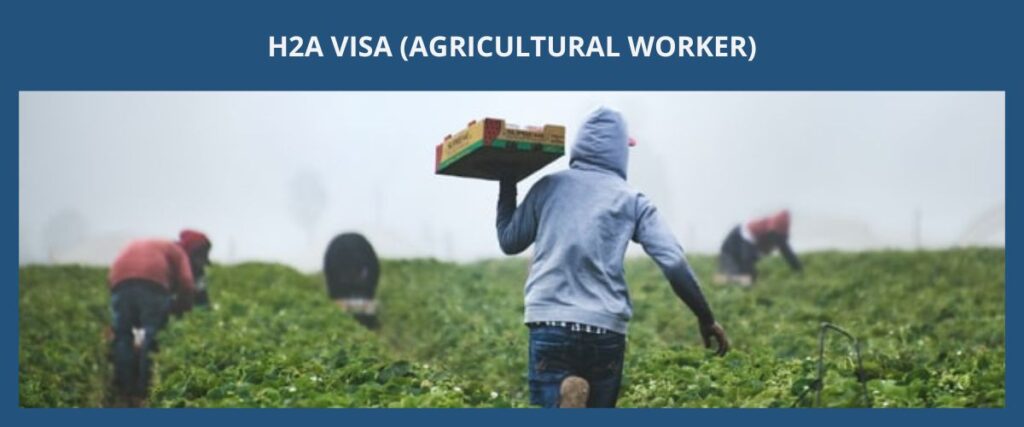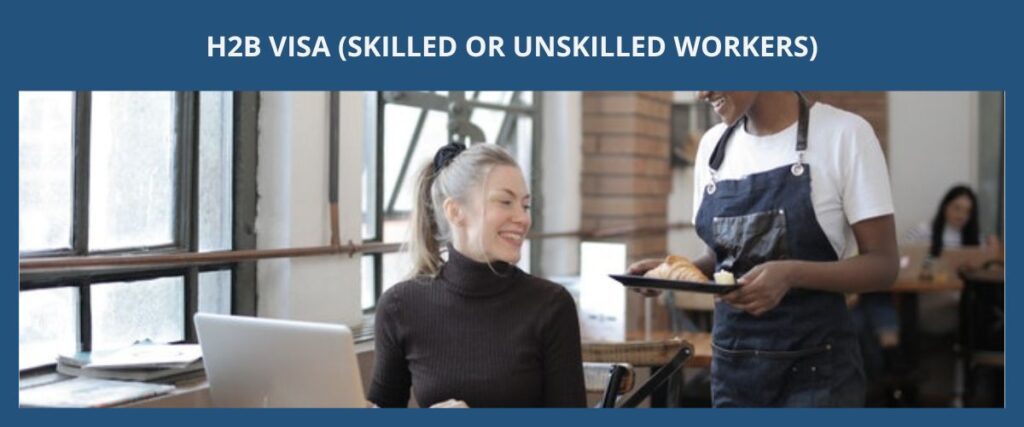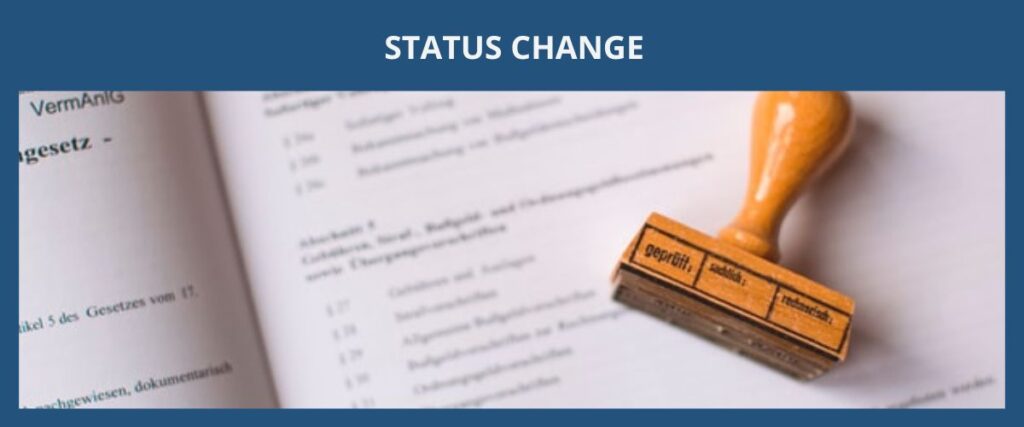The H visas are nonimmigrant (temporary) visas for foreign persons who will be working or receiving certain training temporarily in the United States. The H visas are one of the most commonly used categories for foreign workers in the United States.
There are seven main sub-categories under the H visa:
- H1B Visa [Specialty Occupations]: Persons who have at least a bachelor’s degree in a certain specialty and will be working in that specialty occupation (which requires a bachelor’s degree).
- H1B1 Visa [Chile and Singapore]: Persons from Chile and Singapore who have at least a bachelor’s degree in a certain specialty and will be working in that specialty occupation (which requires a bachelor’s degree).
- H1B2 Visa [DOD]: Persons who will be working in a cooperative research and development project or a co-production project under a government-to-government agreement monitored by the U.S. Department of Defense (DOD).
- H1B3 Visa [Fashion Model]: Persons who are prominent fashion models that have distinguished merit and ability.
- H2A Visa [Agricultural]: Persons who will be working a temporary or seasonal agricultural job.
- H2B Visa [Non-Agricultural]: Persons who will be working a temporary or seasonal (skilled or unskilled) non-agricultural job.
- H3 Visa [Trainee / Special Education]: Persons who are trainees invited to the United States to receive training that is not available in their home country OR persons who will receive training under a special education exchange program.
- H4 Visa [Dependents]: Dependent family members (spouse and unmarried children under 21 years old) of H visa holders.

The H visas cover a wide spectrum of job positions (or activities) and the H visa must be sponsored by (1) a U.S. employer, (2) a U.S. agent, or (3) a foreign employer through a U.S. agent.
The 3 most commonly referred to H visa categories are the H1B visas for professionals in certain job positions (e.g., accountants, engineers, doctors), H2A visas for agricultural job positions (e.g., beekeeper), and H2B visas for (skilled or unskilled) labor focused job positions (e.g., restaurant servers). The H3 visas are for trainees who are only coming to the United States to receive training in a specific field or to participate in a special education exchange visitor program. The H4 visas are for the dependent family members (spouse and unmarried children under 21 years old) of the H visa workers.
H1B Visas (Specialty Occupation, Fashion Models, DOD Workers)
The H1B visas are for persons who will be working (1) in a specialty occupation, (2) as a fashion model, or (3) for the U.S. Department of Defense.
H1B Visa Specialty Occupation
The H1B visa under the specialty occupation category is the most common work visa used by foreign workers who are F1 visa students that have graduated from a U.S. college or university with a bachelor’s degree or a higher degree (e.g., master’s degree, Ph.D. MD, JD). Due to the high demand for H1B visas every year, a lottery system where H1B visa cases are randomly picked for further review is implemented when the H1B visa petitions received are more than the allowed quota of H1B visas that can be given out that year.
H1B1 Visa Chile and Singapore Professionals
Foreign workers from Chile and Singapore can alternatively choose to use the H1B1 visa (which has a number of visas set aside for them from the H1B visa quota) instead of the H1B visa. The H1B1 visa and the H1B visa differ slightly in the regulations (e.g., the H1B1 visa does not have the 6-year limitation but it also is not a dual intent visa), however, the general requirements for the job position and qualifications for the worker remains mostly the same. The H1B1 visa for Chileans and Singaporeans is comparable to the E3 visa for Australians in terms of the regulations and requirements.
H1B2 Visa DOD Workers
The H1B2 visa is for foreign persons who have at least a bachelor’s degree and will be working in a cooperative research and development project or a co-production project that is under a government-to-government agreement monitored by the U.S. Department of Defense (DOD). There can only be 100 H1B2 visas at any given time.
H1B2 visas can be granted an initial period of stay up to 5 years and it can be extended (renewed) in 2-year increments up to a total maximum time of 10 years. H1B2 visa workers are also required to have a foreign residence (i.e., a home address overseas) that they do not intend on abandoning.
H1B3 Visa Fashion Models
The H1B3 visa is for prominent fashion models who have distinguished merit and ability, and will be working in a job that requires a prominent model. In other words, the H1B3 visa fashion model should be accomplished and well-known in the fashion model industry and is coming to the United States for a job that requires a fashion model of their caliber.
Like the H1B visa specialty occupations category, the H1B3 visa fashion model category is also subject to the H1B visa cap (i.e., the annual quota of H1B visas that can be given out each year) which means that the H1B3 visa petitions for fashion models must go through the lottery system where the H1B3 visa cases will be randomly picked for further review.
H2A Visa Agricultural Workers
The H2A visa is for persons from certain foreign countries to work temporary (i.e., less than 1 year) or seasonal (i.e., tied to a certain time of the year) agricultural jobs in the United States. H2A visa workers usually work full-time jobs in farms, orchards, ranges, nurseries, etc.
H2B Visa Non-Agricultural Workers
The H2B visa is for persons from certain foreign countries to work temporary or seasonal (non-agricultural) skilled or unskilled jobs in the United States. H2B visa workers usually work full-time jobs in amusement parks, resorts, restaurants, hotels, housekeeping, and the landscaping industry.
For most H2B visas (which are cap-subject H2B visas), 33,000 H2B visas are given out twice a year (i.e., October 1 and April 1), and a lottery system typically will be implemented to randomly pick out H2B visa petitions for further review due to the high demand of H2B visas (i.e., the number of H2B visa petitions is higher than the number of H2B visas that can be given out during the given period).
H3 Visa Trainee or Special Education Exchange Visitor
The H3 visa is for persons who will be in the United States to receive training provided by a person or an organization in any field (except for physicians in the medical field) or to attend a special education exchange visitor program. The fields of training under the H3 visa include but are not limited to communications, finance, government, agriculture, commercial, transportation, etc.
H4 Visa Family Members
Dependent family members (spouse and unmarried children under 21 years old) of H visa workers are allowed to stay in the United States under the H4 visa status.
Most H visa holder’s dependent H4 visa family members are not allowed to legally work in the United States. The exception is the H4 visa spouse of an H1B visa worker who is covered under AC21 (i.e., who is already in certain stages of their employment-based green card petition). The H4 spouse of the AC21 H1B visa worker would need to obtain an employment authorization document (EAD, Form I-765) before starting to work. Also, only the H4 visa spouse and not the H4 visa child of the AC21 H1B visa worker can legally work in the United States.
The H visa covers a variety of activities, hence, there are different validity time periods for each H visa. The following will only be discussing the period of stays for H visas in generalization.
H Visa Validity Time
The period of stay (i.e., amount of time) typically granted to initial H visas can be up to:
- H1B Visa: 3 years (or for the validity period authorized by the LCA)
- H1B1 Visa: 1 year (or for the validity period authorized by the LCA)
- H2A Visa: 1 year (or for validity period authorized by the Temporary Employment Certification)
- H2B Visa: 1 year (or for validity period authorized by the Temporary Employment Certification which is typically no more than 10 months for most cases or 1 year for one-time occurrences)
- H3 Visa: 2 years (or 18 months for special education exchange visitors)
H Visa Extension (Renewal) Validity Time
The period of stay (i.e., amount of time) typically granted to H visa extensions (renewals) can be up to:
- H1B Visa: 3 years until a total of 6 years in the H1B visa status is reached (and certain H1B visa workers who have pending employment-based green card filed for them can extend beyond the 6-year maximum limitation under AC21)
- H1B1 Visa: 1-year increments and there is no limit on how many years a person can be in the H1B1 visa status (i.e., no maximum limit on how many times an H1B1 visa can be extended/renewed but a new LCA must be filed every 3 years)
- H2A Visa: 1-year increments until a total of 3 years in the H2A visa status is reached
- H2B Visa: 1-year increments until a total of 3 years in the H2B visa status is reached for one-time occurrences
- H3 Visa: extensions can only be granted up to a total of 2 years in the H3 visa status is reached (or 18 months for special education exchange visitors)
Physically Overseas Requirement After Total H Visa Time Limit & Exceptions
In most H visa cases, after the person reaches the total amount of time allowed in that H visa status, the H visa holder will be required to stay physically outside the United States (i.e., overseas) for a certain time period before they can file for a new H visa petition.
The exceptions to the time period to stay physically overseas are for H visa holders who (1) lives overseas but commute to the United States for a part-time job or for work that is intermittent, seasonal, or six months or less each year, or (2) is an H1B visa workers who have an employment-based green card petition initiated for them under the AC21.
Time Required Overseas After Reaching H Visa Status Limitation
The amount of time required to be physically overseas before filing for a new H visa petition:
- H1B Visa: must stay overseas for 1 year after a total of 6 years in the H1B visa status (for most H1B visa cases)
- H2A Visa: must stay overseas for 3 months after a total of 3 years in the H2A visa status
- H2B Visa: must stay overseas for 3 months after a total of 3 years in the H2B visa status
- H3 Visa: must stay overseas for 6 months after a total of 2 years in the H3 visa status
L Visa Status and H Visa Status Counts Towards Total Time Allowed
Under H visas, any period of time the H visa holder was in an L visa status or H visa status (which does not include the H4 visa status or L2 visa status) will be counted toward the maximum time limit of their current H visa status. For example, if the person spent 1 year in an L1A visa status and then changed into an H1B visa status, the person’s maximum time on their new H1B visa status would be 5 years (the 1 year in L1A visa status takes away 1 year from the H1B visa’s 6-year maximum limit) instead of 6 years.
Recapturing H Visa Time
The H1B visa and certain H2 visas that fall under the exceptions allow the H visa worker to recapture the time they spend physically outside the United States for their H visa status (i.e., time not spent in their H visa status can be added back towards the total amount of time allowed in the H visa status). H3 visa trainees cannot recapture any time they spend physically outside the United States.
H Visa Grace Periods (Additional Authorized Period of Stays)
There are usually different periods of additional authorized periods of stays for the respective H visas:
- H1B Visa: can enter the United States 10 days before the start date and stay an additional 10 days after the end date, and has a 60-day grace period if employment is terminated early
- H2A Visa: can enter the United States 7 days before the start date and stay an additional 30 days after the end date but does not have a grace period if employment is terminated early
- H2B Visa: can enter the United States 10 days before the start date and stay an additional 10 days after the end date but does not have a grace period if their employment is terminated early
- H3 Visa: can enter the United States 10 days before the start date and stay an additional 10 days after the end date but does not have a grace period if their trainee program ends early
-eng-1024x427.jpg)
The H visa covers different activities such as working and training which requires different processes in obtaining the respective H visas. The following will only be discussing the H visa petition process in a generalized format.
There are 3 main steps in the general process of obtaining an H visa:
Step 1: Job Offer (or Acceptance to Program) from U.S. Sponsoring Employer
The H visa holder must receive a job offer that qualifies for an H visa job position from a U.S. employer or the acceptance to an H3 visa training program. The U.S. employer must be willing to sponsor (pay for and initiate) the H visa petition for the person which means that the H visa worker cannot self-sponsor themselves for an H visa.
Step 2: Preparing Documentation, Going Through Pre-Filing Requirements, Filing the H Visa Petition with USCIS
H1B Visa Cap-Subject Petitions
For H1B Visa Cap-Subject Petitions (Specialty Occupations & Fashion Models):
- Registering for the Lottery System (if Required that Year)
- Obtaining an Approved LCA Certification (Form ETA-9035)
- Filing the H1B Visa Petition (Form I-129)
The U.S. sponsoring employer must first register the H1B visa worker to enter the H1B visa lottery system if it is required that year (i.e., this happens when the number of H1B visa petitions filed exceeds the amount of H1B visas that can be given out that year). The H1B visa lottery system will then randomly select the H1B visa petitions that can continue on to be reviewed. If the H1B visa worker’s petition is selected, the U.S. sponsoring employer (i.e., their attorney) will then file for a Labor Condition Application (LCA) with the U.S. Department of Labor (DOL) to obtain a determination on the wage that should be offered to the H1B visa worker. After the LCA certification is approved, the U.S. sponsoring employer can then file the H1B visa petition (Form I-129) with the USCIS.
More details on the process of obtaining an H1B visa can be found here.

H2A visa Petitions
For H2A visa (Agricultural Jobs):
- Filing an agricultural job order with the State Workforce Agency (Form ETA-790/790A) & Temporary Employer Certification (Form ETA-9142A) with DOL
- Recruiting U.S. workers & Obtaining approved Temporary Employer Certification (Form ETA-9142A)
- Filing the H2A Visa Petition (Form I-129)
Before the U.S. sponsoring employer can file for an H2A visa petition, it must first complete the requirements with the U.S. Department of Labor (DOL) which includes filing for an agricultural job order with the State Workforce Agency (Form ETA-790/790A), making efforts to hire U.S. workers (e.g., interviewing U.S. applicants and contacting former employees), and obtaining an approved Temporary Employer Certification (Form ETA-9142A). After obtaining the approved Temporary Employer Certification with the DOL, the U.S. sponsoring employer then files the H2A visa petition (Form I-129) with the USCIS.
More details on the process of obtaining an H2A visa can be found here.

H2B Visa Cap-Subject Petitions
For H2B visas (Skilled or Unskilled Non-Agricultural Jobs):
- Filing for a Prevailing Wage Determination (Form ETA-9141)
- Filing a job order with the State Workforce Agency & Temporary Employer Certification (Form ETA-9142B) with DOL and go through lottery if required
- Recruiting U.S. Workers & Obtaining approved Temporary Employer Certification (Form ETA-9142B)
- Filing the H2B Visa Petition (Form I-129)
Before the U.S. sponsoring employer can file for an H2B visa petition, it must first complete the requirements with the U.S. Department of Labor (DOL) which includes obtaining a Prevailing Wage Determination (Form ETA-9141), filing for a job order with the State Workforce Agency, making efforts to hire U.S. workers (e.g., interviewing U.S. applicants and contacting former employees), and obtaining an approved Temporary Employer Certification (Form ETA-9142B).
If the H2B visa cap is reached (i.e., there are more H2B visa petitions than the amount of H2B visas that can be given out for the given period), then the Temporary Employer Certification (Form ETA-9142B) filed for the H2B visa must go through the H2B visa lottery system with the U.S. Department of Labor and be selected for further review. After successfully obtaining an approved H2B visa Temporary Employer Certification from the U.S. Department of Labor, the U.S. sponsoring employer must then file the H2B visa petition (Form I-129) with the USCIS.
More details on the process of obtaining an H2B visa can be found here.

Step 3: Consular Processing or Change of Status (H Visa)
After the USCIS approves the H visa petition (Form I-129), the person will then need to change into their H visa status. There are 2 ways to change into the H visa status: change of status (done in the United States) and consular processing (done outside of the United States).
Change of status is usually for a person who is already in the United States with another valid nonimmigrant visa status and has maintained a lawful visa status throughout their time in the United States. On the other hand, consular processing is for a person who lives outside the United States or for a person who is ineligible to change their status in the United States due to noncompliance of U.S. immigration law (e.g., overstayed on their previous visa status, worked when they did not have valid U.S. work authorization, the visa status they used to enter the United States does not allow them to change into another type of visa status, etc.)
Person Outside U.S. (or Person Ineligible for Change of Status)
For a person who is residing overseas (outside the United States) or a person who is ineligible for change of status with the H visa petition (Form I-129), consular processing must be done to obtain the H visa status. Consular processing involves the person attending an in-person interview at the U.S. consulate or embassy usually in the person’s home country. In certain circumstances, a person can do consular processing in another country as a “Third Country National.”
After the interview approval at the U.S. consulate or embassy, the person would have to be admitted entry into the United States by the CBP officer at the border (usually at the airport) which means that the person would have to physically enter the United States as the final step for the H visa status to be activated.
Person Residing in the U.S. (Maintained Lawful Visa Status)
For a person who is already in the United States with another valid nonimmigrant visa, there are usually two options available to obtain the H visa status:
(1) Change of Status: this is the more commonly chosen option where the person states that they would like to change their status without leaving the United States in their H visa petition (Form I-129). If the person is eligible (no violations of U.S. immigration laws), then their nonimmigrant visa status will be changed upon the approved employment start date listed in the H visa petition. In cases where the person’s change of status request is denied or the person needs to change it into consular processing, an application for action on an approved application or petition (Form I-824) may be required.
(2) Consular Processing: this must be chosen if a person cannot show that they have maintained lawful visa status in the United States or for any other reasons such as the person needs to travel internationally before the H visa petition is approved.

The total time an H visa takes is consisted of the processing time for (1) any required filings with the DOL (such as obtaining an approved Temporary Employment Certification with completing recruitment efforts to find U.S. workers for H2 visas or an approved LCA for H1B visas), (2) the H visa petition (Form I-129) with the USCIS and the (3) visa application (DS-160) at a U.S. consulate or embassy overseas if the person is not already in the United States or is ineligible to do a change of status within the United States.
Factors that influence the H visa petition processing time usually include but are not limited to if there was any Request for Evidence (“RFE”), Request for Information (“RFI”), or Notice of Deficiency (“NOD”) issued, and the caseload of the USCIS service center and the U.S. consulate or embassy.
Premium Processing for Form I-129 (Expedited Service)
A rough estimate for the Form I-129 petition for the H visa is around 2 to 7 months. However, a 15-day premium processing (Form I-907) is available for the Form I-129 part of an H visa petition. Premium processing is an optional expedited service where the USCIS guarantees that the case will be processed within 15 calendar days (not business days). When a notice of intent to deny (NOID) or a request for evidence (RFE) is issued, a new 15 calendar days will start when the USCIS receives a response from the applicant. If the USCIS fails to process within the time frame, a refund of the service fee will be given and the case will continue to be expedited. Please note that USCIS’s guaranteed response may be an approval notice, denial notice, notice of intent to deny (NOID), request for evidence (RFE), or open an investigation for fraud or misrepresentation.
The current premium processing fee for the H visa is $2500 USD and it can be requested when the original petition is submitted to the USCIS or an upgrade to premium processing can be done when the case is pending.

Dual intent visas allow the foreign person to have both an intent to temporarily stay in the United States and an intent to permanently stay in the United States. The intention to permanently stay in the United States can be shown when the foreign person has a pending green card petition with the USCIS or an approved PERM labor certification from the U.S. Department of Labor.
The H1B visa is a dual intent visa which means that it is possible for the person to have a green card (permanent residency) petition pending while still being able to maintain and extend (renew) their H1B visa status in the United States.
On the contrary, visas that are not dual intent visas (e.g., limited dual intent visas) only allows the foreign person to have an intent to temporarily stay in the United States (which means that the foreign person cannot have an intent to permanently stay in the United States and will be denied the visa if they do). The H1B1 visas, H2 visas and H3 visas are not dual intent visas and these H visa holders will face tricky immigration situations regarding their visa status and ability to extend (renew) their H visa status if they have a green card petition filed for them having a pending green card petition because it would show that they do have an intention to permanently stay in the United States (which would violate the nonimmigrant intent required of their visa).
The H visas are for foreign persons who will be working or receiving certain training temporarily in the United States. The H1B visa is one of the most common visas used by F1 visa students to continue their OPT work each year.
If you have an H visa (Bachelor’s Degree Specialty Occupation, Skilled and Unskilled Workers, Agricultural Workers, Trainees, Special Education Visitors) immigration question, please fill out our contact us form or send us an email with some basic information about your background and your immigration needs. We will do our best to respond within 48 hours.
How we can help?
Kylie Huang Law’s immigration attorney will help identify whether the H visa is the appropriate nonimmigrant visa category for the client’s (or the client’s beneficiary’s) professional background and if there are other visa options for the client (or the client’s beneficiary). We will work closely with our client to prepare a convincing case for their (or it’s) H visa petition and we will also strategize on how the H visa petition should be presented to achieve the best chances of approval. It is strongly advised and common practice to retain an immigration attorney for an H visa petition due to the complexities in the immigration process and visa requirements.
What does the typical process look like to retain (hire) us?
- Step 1:
- Step 2:
- Step 3:
- Step 4:
- Step 5:
- a.
- b.
- c.
- Step 6:
- Step 7:
- Step 8:
- Fill out the form (with some basic information on what your immigration needs are)
- Sign up and log into the client portal to schedule an appointment online
- Attend scheduled appointment (typically a phone call or zoom meeting)
- Retainment (signing a contract to hire us)
- Start processing case
- Gathering required documents
- Preparing paperwork
- Confirming contents of documents that will be submitted
- Filing the case
- Following up on the status of the case
- Close the case when a final determination is issued
- Step 1:
- Step 2:
- Step 3:
- Step 4:
- Step 5:
- a.
- b.
- c.
- Step 6:
- Step 7:
- Step 8:
- Fill out the form (on what your immigration needs are)
- Sign up and log into the client portal to schedule an appointment
- Attend scheduled appointment (typically a phone call or zoom)
- Retainment (signing a contract to hire us)
- Start processing case
- Gathering required documents
- Preparing paperwork
- Confirming contents of documents that will be submitted
- Filing the case
- Following up on the status of the case
- Close the case when a final determination is issued
- Step 1:
- Step 2:
- Step 3:
- Step 4:
- Step 5:
- a.
- b.
- c.
- Step 6:
- Step 7:
- Step 8:
- Fill out the form (on what your immigration needs are)
- Sign up and log into the client portal to schedule appointment
- Attend scheduled appointment (typically a phone call or zoom)
- Retainment (hire us)
- Start processing case
- Gathering required documents
- Preparing paperwork
- Confirming content of documents that will be submitted
- Filing the case
- Following up on the case status
- Close the case when a final determination is issued

